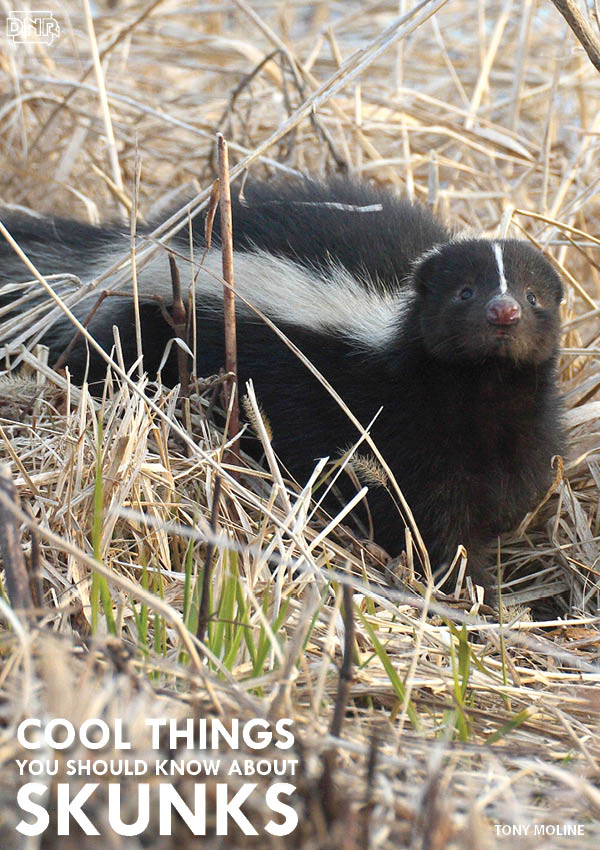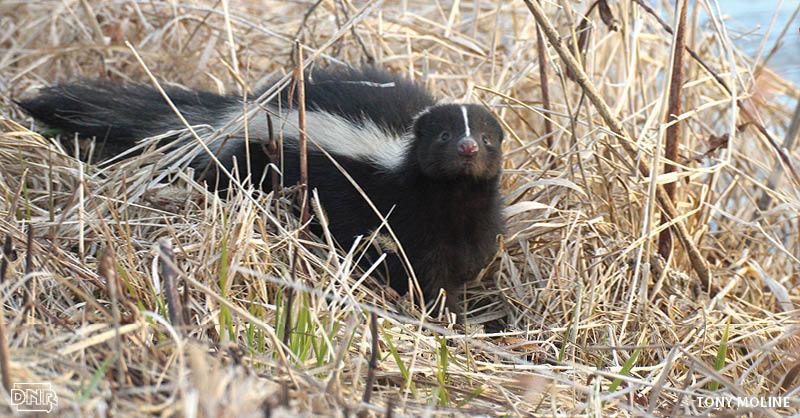When you think of skunks, you probably think of their stinky spray or how they dig up your lawn. But did you know that they play an important role in insect control and sometimes even the production of fragrances?
1. Skunks will eat almost anything
Skunks munch mainly on insects, berries, nuts, and some plants, making them omnivores. Ground-nesting bees and wasps make for a delectable skunk snack, especially the larva. Opportunistic hunters, skunks will catch mice, snakes, toads and other small prey they come across, in addition to leftovers from other predatory animals.
 2. Mammal with many voices
2. Mammal with many voices
Skunks can squeal like a pig, chirp like a bird, whimper like a dog, whine, and even grumble and grunt when upset. They also smack their lips when content.
3. I warned you
Skunks warn predators and competitors of the impending stench by stomping their feet, clicking their teeth and raising their tails. They hold their ground or run directly toward a threat and stop – sometimes with only a few inches to spare – to encourage retreat. If the enemy doesn't heed the warning, the skunk turns and sprays with both ends facing its target.
4. Stinky baby
Skunks can emit musk at eight days old and can spray at about a month old. Adults aim accurately within 10 feet, but the spray can go 20 feet with the help of wind. You can smell skunk spray from at least a mile and a half away. Skunks hold enough odorous liquid to spray 5 or 6 times before needing to replenish; glands take 8 to 10 days to refill.
5. Sulfuric scented tomato
Contrary to the old myth, tomato juice isn’t the most effective way to get rid of the stench of skunk spray – it just masks the smell. In an open container, mix together ¼ cup baking soda, a fresh 1 quart bottle of 3 percent hydrogen peroxide, and 1 to 2 teaspoons of liquid dish detergent. Use it right away, as the mixture can’t be stored without losing its power. Don’t use this on cloth, it can remove color.
6. I’m not eating that
The skunk’s main predators include owls and other large birds of prey, like hawks and eagles. Other than vultures, these raptors can't smell and strike quickly from above. Mammals like coyotes and large domestic dogs prey on skunks, but usually only if there’s no other food source available.
7. Slow and smelly
Since skunks can’t run more than 10 miles per hour, they spray enemies instead of running away. Skunks often end up as road kill because drivers expect them to react like other animals and run off instead of staying put.
8. Little bear
A skunk’s tracks look like mini bear tracks. Both feature long claws, five toes, a heel pad and a metacarpal pad. Surprisingly, skunks and bears eat mostly the same things as they’re both omnivores.
9. They’re everywhere!
The striped skunk’s natural range extends from southern Canada to northern Mexico. They’re good at adapting to living around humans, so their range remains largely unaffected by human expansion unlike its relative, the spotted skunk.
10. Spot needs food
The spotted skunk population has declined greatly, making them endangered in Iowa. They were heavily sought after during the 1930s and 1940s for their fur, but loss of habitat and food sources ultimately led to their now miniscule numbers. If you see a spotted skunk in Iowa, report it to the DNR.
11. Taking over
Skunks prefer to live within a mile or two of water in wooded areas, but they can adapt to living in urban areas, such as under a porch, in a brush pile or in a hollow tree. Normally, they take over groundhog, rabbit or fox dens instead of building their own. They’re even known to allow groundhogs and rabbits to remain in the same den – except when the females have young kits.
12. Snow day
During the winter and early cool spring, skunks come out at almost any time of day, especially after a heavy snowfall or cold snap. They slow down considerably in cold temperatures, but do not hibernate. To stay warm, skunks sometimes share dens with more than a dozen others.
13. Food for thought
When temperatures increase, skunks stay primarily nocturnal. They’re commonly seen in the evening and early morning, but twilight provides the best time for foraging. Females with kits forage during the day so they can stand guard at night. Known to revisit good feeding spots over their entire lifetime, skunks pass on that knowledge to their offspring.
14. Not so noisy neighbors
Skunks reap the benefits after a dog or raccoon knocks over a trash can, even though they can’t do so themselves. They dig holes while looking for one of their favorite meals, white grubs, but only in yards already infested with the juicy morsels. Raccoons, squirrels, moles and gophers all dig in yards too.
15. Skunk in the day, run away?
Skunks aren’t more likely to get rabies than other mammals. A rabid mammal must transfer the virus to the skunk, via bite, before they carry it. Don’t assume a skunk has rabies if you see it out during the day; they can be out at any time. If a skunk or other animal acts strangely, give it space.
16. Fragrance booster
Skunk oil (musk) used to be an ingredient in perfume. Rarely, you can still find it in its natural form, but most comes from a lab now. Musk holds the desired scent in longer than other types of oil or distilled water and aids in keeping the perfume from vaporizing.
